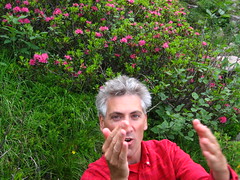It's always a pleasure to hear Herbert talk. He's an inspiring presenter, which unfortunately is not too common amongst conference speakers. When he speaks, he makes clear what tends to be hard to grasp in his writings, that tend to have an information density that is hard to follow for mere mortals. When I read the D-Lib article a while ago, I did not fully grasp the depth and vision; with this talk, the penny dropped.
What really made this a great finish of a a day that was pretty good already, was that this was about thinking further into the future. The other talks were about the next step, current dilemmas, what to this year, maybe the next: using instant messaging and blogs to communicate with clients, or improving your OPAC's search results. All find and dandy, I certainly got some ideas; but the scope of this talk was a much wider vision, which might take a decade to come to fruition.
We've made the first transition, from writing articles on paper, to writing articles electronically. But the idiom of the research workflow, the way scientists and scholars cite sources, has not changed yet. We've merely swapped one medium for another. With this transition well on its way, it's time to re-think the whole scholarly workflow.
And the first step is to build a uniform mechanism for referencing objects. This is necessary for machines to follow the research workflow from one source to another, which will make it possible to build all kind of services on top of the objects. Think recommenders on basis of recent citations (recent as in: without the publication lag, that can run up to two years for slow-moving journals!). Think overlay journals that work. Think archiving services (LOCKSS) that function automatically. It could work! And if anyone could pull it off, it's van de Sompel, who brought us the OAI and OpenURL architecture (*).
(*) He's not alone, of course, he's surrounded by some really bright people, and LANL is the perfect place for this type of research. But he's the essential hub.

No comments:
Post a Comment